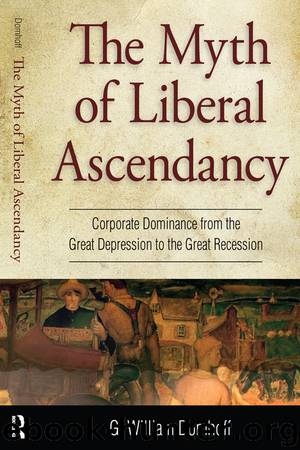The Myth of Liberal Ascendancy by Domhoff G. William

Author:Domhoff, G. William.
Language: eng
Format: epub
ISBN: 9781317255802
Publisher: Taylor & Francis (CAM)
THE RISE OF PUBLIC-EMPLOYEE UNIONS
Although the origins of the American Federation of Teachers, the International Firefighters Association, and the National Federation of Federal Employers went back to World War I, few public-employee unions managed to gain a toehold in cities and states until the 1950s, usually by signing up white-collar workers in municipal government. A bill introduced into both the House and Senate in the late 1950s to give federal employees the right to organize offered new hope, but it did not cause a stir until it was introduced once again at the outset of the Kennedy years. Suddenly, the bill was seen as threatening not only to most members of the conservative coalition but to government executives as well. Several Kennedy aides, fearful that Congress “might enact a bill that gave workers too many rights and unions too much power,” suggested that the president issue an executive order “intended to placate his labor allies while ensuring that the advent of collective bargaining in the federal service would alter labor relations as little as possible” (McCartin 2011, pp. 35–36). Organized labor, in contrast, greeted the proposed legislation with enthusiasm, hoping to organize workers at the federal level and then turn to state and municipal employees in the parts of the country in which union organizing had failed.
Lawyers for the Department of Defense wrote the first draft of the preemptive executive order based on the claim that unionized employees might impede defense production. Ninety-two work stoppages between 1956 and 1961 by skilled craftsmen at the National Aeronautic and Space Administration were the primary basis of their concern. After learning of this effort, Secretary of Labor Goldberg took control of the process by creating a task force that included representatives from several departments and agencies, including the Department of Defense, the Bureau of the Budget, and the Civil Services Commission, all three of which wanted the most narrow order possible in order to limit union powers.
The executive order finally issued in 1962 was indeed narrow in scope. It emphasized that federal employees need not join a union, ruled out strikes, included few of the procedures the AFL-CIO requested, and was soon made even more restrictive through interpretations by the Civil Service Commission. But union leaders praised it in public because it gave them the right to organize federal workers. As the labor organizers had anticipated, there was a rapid rise in membership for most public-employee unions, including at the state and local levels, with twenty-three states passing laws permitting public sector bargaining by 1970. For the most part, they were states in which liberal unions had used a variety of activist tactics and the Democrats had a legislative majority (Miller and Canak 1995a). The growth in public-employee unions was “the biggest breakthrough for labor since the New Deal” (McCartin 2011, p. 43).
The corporate community’s reactions to this new organizing drive broke along the usual moderate/ultraconservative lines. The NAM and Chamber of Commerce insisted that public-employee unions should be restricted to the right to meet and confer, but with no right to collective bargaining.
Download
This site does not store any files on its server. We only index and link to content provided by other sites. Please contact the content providers to delete copyright contents if any and email us, we'll remove relevant links or contents immediately.
| Anthropology | Archaeology |
| Philosophy | Politics & Government |
| Social Sciences | Sociology |
| Women's Studies |
The Secret History by Donna Tartt(18168)
The Social Justice Warrior Handbook by Lisa De Pasquale(11956)
Thirteen Reasons Why by Jay Asher(8457)
This Is How You Lose Her by Junot Diaz(6442)
Weapons of Math Destruction by Cathy O'Neil(5837)
Zero to One by Peter Thiel(5495)
Beartown by Fredrik Backman(5366)
The Myth of the Strong Leader by Archie Brown(5241)
The Fire Next Time by James Baldwin(5021)
How Democracies Die by Steven Levitsky & Daniel Ziblatt(4965)
Promise Me, Dad by Joe Biden(4909)
Stone's Rules by Roger Stone(4865)
100 Deadly Skills by Clint Emerson(4694)
A Higher Loyalty: Truth, Lies, and Leadership by James Comey(4554)
Rise and Kill First by Ronen Bergman(4547)
Secrecy World by Jake Bernstein(4390)
The David Icke Guide to the Global Conspiracy (and how to end it) by David Icke(4384)
The Farm by Tom Rob Smith(4328)
The Doomsday Machine by Daniel Ellsberg(4248)
